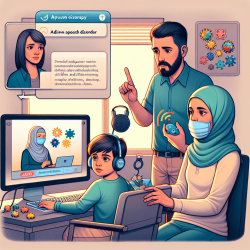Introduction
In the realm of speech-language pathology, data-driven decisions are crucial for creating effective interventions, especially in online therapy settings. The research article "Self-reported safety belt use among emergency department patients in Boston, Massachusetts" provides valuable insights that can be leveraged to enhance online therapy services for children, such as those offered by TinyEYE. By examining the outcomes and methodologies of this study, practitioners can refine their approaches and encourage further research to improve therapy outcomes.
Key Insights from the Research
The study conducted by Fernandez et al. (2006) explores the prevalence and correlates of safety belt non-use among emergency department patients in Boston. It highlights several factors associated with safety belt non-use, including male gender, alcohol consumption, and the perception that safety belts are uncomfortable. The study also emphasizes the importance of targeted interventions in emergency departments to increase safety belt use among at-risk populations.
Applying Research Findings to Online Therapy
While the research focuses on safety belt use, the underlying principles can be adapted to enhance online therapy for children. Here are some ways practitioners can apply these insights:
- Identify At-Risk Populations: Just as the study identifies demographics with lower safety belt use, online therapy providers can identify children who may be at risk of lower therapy engagement. Factors such as age, gender, and socioeconomic status can be considered to tailor interventions.
- Utilize Multivariate Analysis: The study uses multivariate logistic regression to analyze factors associated with safety belt non-use. Similarly, therapists can use data analytics to identify patterns in therapy outcomes, allowing for more personalized and effective interventions.
- Address Perceived Barriers: The research highlights discomfort and forgetfulness as barriers to safety belt use. In online therapy, practitioners can identify and address barriers such as technological challenges or lack of parental involvement to improve therapy adherence.
- Implement Targeted Interventions: The study suggests ED-based interventions to increase safety belt use. Online therapy providers can develop targeted interventions for children who exhibit specific challenges, using data to inform the design and delivery of these interventions.
Encouraging Further Research
The research by Fernandez et al. underscores the need for ongoing research to develop effective interventions. Online therapy practitioners can contribute to this body of knowledge by conducting studies on therapy effectiveness, engagement strategies, and outcome measurement. By sharing findings, practitioners can collectively enhance the quality of online therapy services.
Conclusion
Incorporating research insights into online therapy practices can significantly enhance outcomes for children. By focusing on data-driven decisions and addressing barriers to engagement, practitioners can create more effective and personalized therapy experiences. To explore the original research paper, please follow this link: Self-reported safety belt use among emergency department patients in Boston, Massachusetts.










